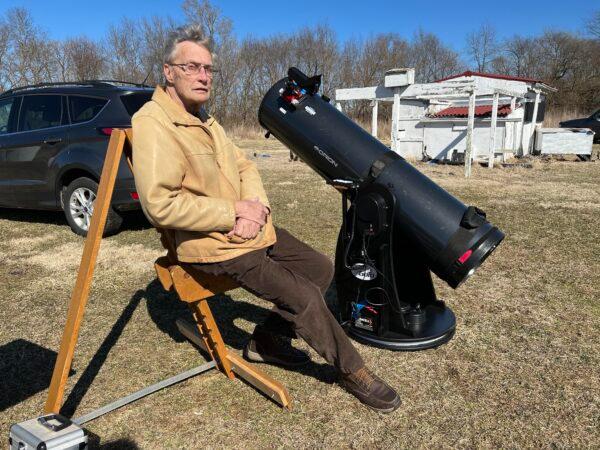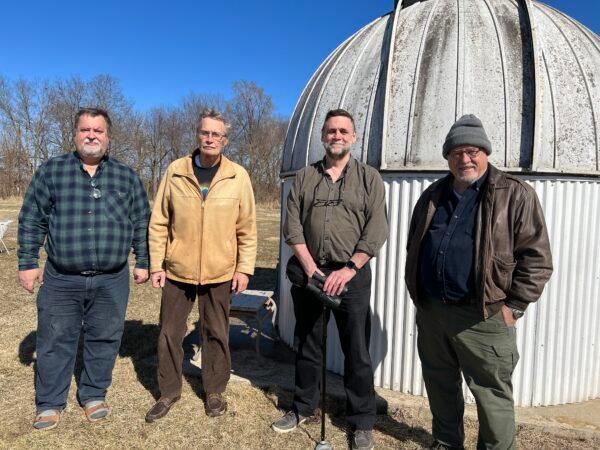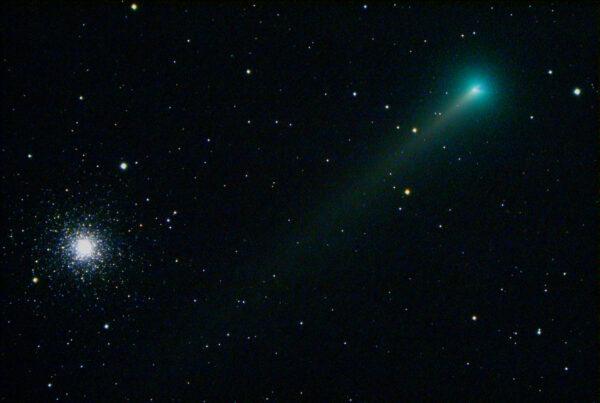One evening, viewers of a virtual “star party” hosted from central Illinois got a glimpse of their host’s passion for the night sky when the patterned group of stars known as the constellation Orion the Hunter came into view.
The regular Friday night gatherings of amateur astronomers observing celestial objects are hosted by Dr. John Martin, associate professor of astronomy-physics at the University of Illinois Springfield. He shows them what is viewable from the university’s observatory. Orion is among his favorites. “I love Orion because when I was a kid, and I was first learning the constellations in the sky, … I had a lot of trouble, actually, trying to figure out the constellations, trying to orient myself outside,” Martin, who grew up in suburban Washington, D.C., told the star party participants. “I didn’t have that many stars to work with, but the first constellation I was able to pick out in the sky and identify on my own was Orion, and that’s because Orion is made up of several bright stars.”
Three stars fashion Orion’s belt, and four stars make up his shoulders and knees. Fainter stars represent his head and a club he’s holding over his head. “Those seven stars there are really the iconic part of it,” Martin said.

As part of the life adjustments we’ve had to make as a result of the pandemic, the creative ways in which people can view the stars at night, or “stargaze,” from one’s backyard have expanded. Your “backyard” can be a virtual platform like the University of Illinois Springfield’s star parties, an observation field in a rural area, or a destination road trip in the United States. And, of course, your actual backyard.
Members of the nonprofit Sangamon Astronomical Society in central Illinois, which promotes astronomy in the community, have launched view parties from such locales and more. Also, they speak about the equipment (particularly binoculars and telescopes) that can be used to experience what we all have in common: the night sky.
“The night sky is one of the few things that every human being who’s ever lived has [had] as a shared experience,” Martin said. “Every human being who’s ever lived has been able to see the night sky. It hasn’t changed that much in 10,000 years of human recorded history.”
Viewing the Sky
Instruments people use to view the night sky have changed, and in a sense, so has the night sky. Of particular concern when it comes to stargazing is what’s known as “light pollution,” which is stray light from urban areas that is scattered into the night sky, making it more difficult to see stars. Hobby stargazers use the Bortle Dark Sky Scale to measure the brightness of a night sky for a certain location. The scale has nine levels, with Class 1 being “as dark as it can get” and Class 9 being extreme light pollution.
Sangamon Astronomical Society member John Myers lives on the west side of Springfield, Illinois, where the Bortle scale is Class 6. He frequently travels to New Mexico, where the Bortle scale is Class 1, to do long-exposure astrophotography, or taking photographs of objects in space. Myers used the website Telescopius.com to help plan his astrophotography trip to New Mexico for “galaxy season.” The website tracks what objects are going to be in the sky.
“At different times of the year, different objects are up because of the rotation of the Earth around the sun,” Myers, a retired attorney, said. “In the spring, it’s called ‘galaxy season,’ because the Earth is optimized for viewing part of the universe. … You’re looking out of the Milky Way, so you can see more galaxies.”

While in New Mexico, Myers used his astrophotography equipment—a telescope and dedicated astronomical camera—to capture a photo of the Horsehead Nebula, which is a small, dark nebula (cloud of gas and dust) in Orion. “I retired, and I got into it in a big way,” Myers said. “It’s very consuming in terms of time, and astrophotography tends to be somewhat costly also because you want to do it right. You’ve got to buy all this equipment.” For people who are just starting out, Myers suggests that they first try using binoculars.
On any given weekend, one might find one or two people at Sangamon Astronomical Society’s observation field outside of Pleasant Plains, Illinois. Several members set up stargazing equipment there for a visitor on a sunny Sunday afternoon. Known as the “primary binocular guy” of the group, Dr. Bernd Estabrook saw his first globular clusters and galaxies with large binoculars his wife gave him about five years ago.
“I spent, then, maybe the next year or two going outside,” said Estabrook, who is a professor of German language and literature at Illinois College in Jacksonville, Illinois. “I come from Nevada where you can see probably 40 deep-sky objects with the naked eye, and here [in Illinois], if you get three, you’re lucky.”
Estabrook has several binoculars, among them a 10x50 (magnification power by diameter of lens), which he considers easily portable. “In Illinois, that’s doubly important because the weather changes so fast, and if you do have a great moment, you’d better get out there quickly because otherwise, you’re not going to see anything,” he said.
The next step would be the purchase of a telescope, which allows a closer look at distant objects in the sky such as planets, galaxies, and nebulae.

The book “Seeing in the Dark” by Timothy Ferris, about how amateur astronomers are making critical discoveries, was the push Bruce Patterson needed to turn his interest in astronomy into a visual hobby. He bought his first telescope in 2003. “I was thrilled the first time I saw the Milky Way through a telescope, the first time I saw the Globular Cluster in Hercules,” said Patterson, a retired lawyer who is the Society’s president. Patterson’s current 12-inch reflecting telescope uses mirrors that reflect light and form the image seen in the sky. The telescope is on a mount that allows the Newtonian telescope to freely move. The telescope has a computer attached to it that helps him locate celestial objects available to view according to the day, time, and location.
John Myers’s computer-controlled refractor telescope (which uses a system of lenses to collect light and form an image) was one of several telescopes that Myers took with him to New Mexico. Its features include a guide scope (an optical device for tracking one’s target) and guide camera for “very, very good accuracy” in taking two- and three-minute pictures.
Mark Lovik, on the other hand, does “significant observing” in his backyard in Chatham, Illinois, using Electronically Assisted Astronomy (EAA), which is a cross between astrophotography and visual observing. He uses different telescopes for visual stargazing and for EAA. “EAA allows me to see faint objects using modest telescopes in my backyard that normally would require huge telescopes in dark skies,” Lovik said.
Myers’s favorite starter telescope is a Celestron telescope with “StarSense Explorer” that uses a “smartphone to analyze the night sky and calculate its position in real time.”
Anyone Can Stargaze
People from all walks of life enjoy the hobby of stargazing, Myers said, though many stargazers are men. “A part of that, I think, [is because] women tend to be a little skeptical about being out alone at night, and I don’t blame them,” Myers said. A lively astronomy community exists on the internet, an example being CloudyNights.com. The site’s forum, books, and resources can help astronomers plan outings.

Stargazing’s benefits are like fishing, hunting, or playing golf, Myers said. “It’s partially about being out in nature, and it’s partially about the camaraderie when you’re with other knuckleheads out here doing the same thing,” Myers said.
Estabrook feels awe when he stares into the sky. “If you want perspective on the world, stare up at the stars, and you realize that all of the things that bother you, and annoy you and get in the way, those things are small,” Estabrook said. “I don’t mind feeling small myself because there’s a sense of awe.”
STAR PARTIES – Light, location, lenses
When setting up your own star party, take the following factors into consideration:
Light and Location: Travel 20 to 30 miles outside of city limits to get away from light pollution, NASA suggests. The darker the sky, the more you can see.
Visit online sites such as LightPollutionMap.info for Bortle Dark Sky Scale ratings in a particular location. The website Telescopius.com can also help when planning where to view. Free sky maps are available at SkyMaps.com.
Give your eyes 15 to 20 minutes to adjust to the darkness of the observation site, using red flashlights to get around. Make sure you have clear views in the direction of things you want to observe.
Lens: You can view with your naked eyes, binoculars, or telescopes. For solar observing, you need special binoculars and telescopes.
This article was originally published in American Essence magazine.




